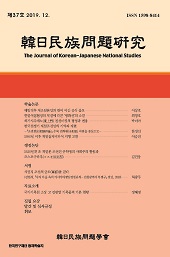학술논문
일본의 근대 철도 건설에 참여한 조선인 노동자
이용수 45
- 영문명
- Korean Workers introduced into the Japan’s Modern Railway Construction: Railway Memorial Monuments of the Hisatsu Line and the Sanin Line
- 발행기관
- 한일민족문제학회
- 저자명
- 간행물 정보
- 『韓日民族問題硏究』제42집, 117~153쪽, 전체 37쪽
- 주제분류
- 인문학 > 역사학
- 파일형태
- 발행일자
- 2022.06.30
7,240원
구매일시로부터 72시간 이내에 다운로드 가능합니다.
이 학술논문 정보는 (주)교보문고와 각 발행기관 사이에 저작물 이용 계약이 체결된 것으로, 교보문고를 통해 제공되고 있습니다.

국문 초록
近代日本において土木建設事業は朝鮮半島の植民地支配と中国大陸での 経済的利益の確保という政治的·軍事的目的を達成するため、先導的な役 割を果たした。特に鉄道の建設は近代国民国家の建設と植民地拡大において 最も重要な役割を担った。鉄道の建設は「帝国の血管」を建設する過程であっ た。
帝国日本を建設した土木建設業界では、労働力の不足という課題に直面し た。この当面の課題の解決のため、外国人労働者の導入を図った。京釜鉄 道の建設を通し、日本の土木建設業は朝鮮人労働者を雇用する直接的な労 働関係を経験した。この過程で不熟練朝鮮人労働者の優秀性に注目した日 本の土木建設会社は、日本の近代鉄道建設のため朝鮮人労働者を移入し現 場に投入した。
日本の土木建設業界は鉄道建設後、記念碑や追悼碑など様々な種類の 鉄道碑を建てた。このうち1900年代~1910年代に建てられた鉄道慰霊碑は、朝 鮮人労働者の日本移入過程を裏付けるものである。一つは1908年10月、間 組が建てた「鐡道工事中殉難病歿者追悼紀念碑」であり、もう一つは1911年 10月に鐡道工業合資會社が建てた「鐵道工事中職斃病歿者招魂碑」であ る。
鉄道慰霊碑に刻まれた朝鮮人労働者の名前は、朝鮮人労働者の日本移 入の歴史を記憶する史料であり、日本の労働市場の変化を裏付ける資料である。朝鮮人の不熟練労働者は、人手不足に陥った日本の土木建設業界にお いて代案的な労働力であった。日本の土木建設業界が積極的に導入した朝 鮮人労働者は、日本における外国人労働者問題の始まりである。
영문 초록
In modern Japan, civil engineering construction projects played a leading role in achieving the political and military objectives, such as colonial rule of the Korean Peninsula and securing economic benefits from the Chinese mainland. In particular, the construction of railroads played the most important role in building the modern nation state and expanding colonial territories. In short, the construction of railways was the process of building the ‘blood vessels of the empire’.
The Japanese civil engineering construction industry, in the process of building Empire Japan, faced the challenge of labor shortage. In order to solve this urgent problem, foreign workers were introduced. Hiring Korean workers while building the Gyeongbu Line in Korea, Japan’s civil engineering construction industry experienced the first direct labor relationship with Korean workers. From this experience, Japanese civil engineering construction companies noticed that unskilled Korean workers were excellent labor force. In order to build Japanese modern railways, Korean workers were introduced to the construction sites by migrating them from Korea to Japan.
Completing the construction of railways, the Japanese civil engineering construction companies built many railway monuments and memorials. Some of these monuments and memorials, built in the 1900s and 1910s, shows how Korean workers had moved into Japan. One is Tetsudoukouchoujunnanbyoubotsushatsuitoukinenhi(the Memorial Monument for Those Died of Diseases and Accidents during the Railway Construction), built by Hazamakumi in October 1908, and the other is Tetsudoukoujichuushokuheibyoubotsushashuukonhi(the Evocation Monument for the Deceased Workers during the Railway Construction), built by Tetsudoukougyougoushigaisha(the Unlimited Partnership Company of Railway Industry) in October 1911.
The Korean workers’ names engraved on those railway memorial monuments have become historical records to prove the entry of Korean workers into Japan and henceforth changes in the Japanese labor market. Korean unskilled workers were an alternative labor force in the Japanese civil engineering construction industry facing labor shortages. Korean workers, migrated from Korea into Japan by the Japanese civil engineering construction industry, were the first bearers of the foreign workers’ issues in Japan.
목차
Ⅰ. 머리말
Ⅱ. 일본의 근대와 철도
Ⅲ. 경부철도 건설과 일본의 토목건설업
Ⅳ. 히사쓰선(肥薩線)의 부설과 조선인 노동자
Ⅴ. 산인선(山陰線)의 부설과 조선인 노동자
Ⅵ. 맺음말
키워드
해당간행물 수록 논문
참고문헌
교보eBook 첫 방문을 환영 합니다!

신규가입 혜택 지급이 완료 되었습니다.
바로 사용 가능한 교보e캐시 1,000원 (유효기간 7일)
지금 바로 교보eBook의 다양한 콘텐츠를 이용해 보세요!





